The Padres spent the offseason building and building. Now they look like a powerhouse.

Preller already had acquired Justin Upton, James Shields, Matt Kemp, Wil Myers, Derek Norris and Will Middlebrooks in a process now known somewhat fondly as Prellerpalooza. Expectations for the Padres in 2015 grew in correlation to the number of big names. A formidable contender was born overnight, or so it seemed.
This year, the Padres enter Opening Day with similar buzz and expectations. The emergence of prospects such as Tatis, plus the free agent signings of Eric Hosmer and Manny Machado in consecutive years — a slow accumulation of talent by Preller’s frantic standards — helped them make the playoffs in 2020.
But as if spurred by the franchise’s first postseason appearance in more than a decade, Preller tossed patience into the Pacific Ocean again and engineered Prellerpalooza: Pandemic Edition. He swung deals for all-stars and Cy Young contenders Yu Darvish and Blake Snell on back-to-back days. He traded for young San Diego native Joe Musgrove. He signed the latest Korean star to make the leap to the majors, Ha-Seong Kim. He signed proven closer and former all-star Mark Melancon. The Padres became World Series contenders again — an overnight powerhouse.
Myers is the only holdover from the original makeover. He said he feels something different around this team compared with the one he joined in 2015, though comments such as those can always be dismissed as typical spring training optimism. But Myers had evidence to back the assertion: Key parts of this Padres team, including Hosmer, Machado, Tatis and others, have already made a playoff run, even if it did come after a shortened season.
“That’s the first time I’ve come into spring training after being in the postseason, which is a big deal,” Myers said. “ … It’s not hopeful this year. It’s more a matter of fact that we are good.”
Because they are good, the Padres are also emerging as something of a symbol as players and fans bemoan the failure of many smaller-market teams to invest in homegrown stars and free agents.
According to the market score used to determine revenue-sharing amounts in MLB’s collective bargaining agreement, the Padres play in a smaller market in terms of population, income and cable television households than all but five other teams. The Baltimore Orioles, Colorado Rockies, Miami Marlins and Cleveland Indians have better market scores — in other words, are closer to the size of the average major league market — than the Padres.
That a similar, if less expensive, splurge failed spectacularly six years ago has done little to dampen expectations this time around. If anything, the biggest concern around Padres hopefuls is the existence of the Los Angeles Dodgers an hour and a half to the north in the same division. A deep postseason run may not require winning a division title, but it probably requires going through Los Angeles one way or another. To the extent that the reigning World Series champions and best team of the past half-decade can be on the defensive, the Padres put the Dodgers there this winter.
Hosmer remembers that, when the Padres pitched him on signing with the team before the 2018 season, executives told him they saw many of the same things in San Diego that helped Hosmer and the Kansas City Royals to back-to-back runs to the World Series. They had a strong minor league system, restocked in part by offloading many of those 2015 acquisitions and Preller’s aggressive international spending. They thought they would have a core graduating to the majors soon and that Hosmer could help raise the youngsters in a winning culture.
But unlike the Royals, who added to their homegrown core as needed, the Padres built their team with lots of outside talent and will fill in with homegrown players. In fact, there are multiple possible iterations of their Opening Day lineup that may not feature any players the organization drafted and developed, though players such as Tatis and Jake Cronenworth certainly came into their own after the Padres acquired them.
Still, unlike six years ago, this Padres team is grounded in proven veteran talent and the promise of more young talent on the way. The Padres have two players in Baseball America’s top 11 prospects, neither of whom will crack the big leagues by Opening Day, and the sixth-rated farm system in the majors.
In other words, Preller managed to acquire a massive talent haul without emptying the minor league system the way he did when he traded away future regulars such as Yasmani Grandal, Trea Turner, Joe Ross, Max Fried and others in that last winter splurge. Hosmer said he believed the Padres would develop enough talent to contend eventually but admitted even he didn’t see this kind of furious influx of outside talent coming.
“Definitely not to this extreme. If you would have told me Manny would be here a year after me, followed by Snell and Darvish …” Hosmer said. “I had an idea of this team being good and having a lot of talent here, but this amount of talent on one team is pretty special.”
But no one knows better than the Padres how quickly hopes can shrivel and talent can disperse. Accumulating talent is the easy part, relatively speaking.
“We realize we’re certainly built to win a championship and we have the pieces we need to win a championship,” Hosmer said. “But there’s a lot of steps we need to accomplish before we’re even thinking about that.”






